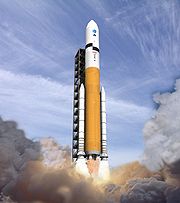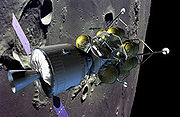Constellation Program is a program developed by NASA for new misions around the Earth and missions to the Moon and for developing astronautical vehicles for these missions. The vehicles are also planned to be used for launching modules up in space and to the Moon that then shall be composed together to greater vehicles for manned missions to Mars and other far objects.
The vehicles developed and under developing are planned to replace the space shuttles when these are taken out of service. In some respects, the constellation program goes back to a simpler and more small-scale design of the type that was used in the Apollo program.
The space vehicle battery developed or under developing consists of the Ares I and Ares V rockets, Orion (also known as the Crew Exploration Vehicle), Earth Departure Stage and Lunar Surface Access Module (Altair) .
These craft will be able to conduct a series of missions and assignments in orbit around the earth and missions to the moon.
Most of the Constellation program's hardware is based on systems originally developed for the space shuttle, but Orion's two-part crew and service module system is heavily inspired by the former Apollo program. Future missions in the Constellation program will therefore make use of techniques to dock spacecraft in Earth orbit and lunar orbit, developed and used in the 1960s.
Constellation program will include both unmanned and manned missions. It is currently planned 18 missions in the program, including some to the International Space Station, and a minimum of two lunar landings, the two first since the Apollo program ended.
The Ares I rocket
Ares I is a rocket to launch smaller payloads, and to lift the manned module Orion . It is part of the Constellation program.
Ares I will with high probability to be the rocket that will be used to launch the replacement for the Space Shuttle, the Orion spaceship.
Ares I is constructed as a two-stage rocket powered by rocket-engine J-2X.
The capsule-formed space-ship, Orion, for the person transports will be mounted in the top. Orion is scheduled to lift up to six people in orbit around the Earth. Ares I is also planned to act as a pack mule to deliver resources and supplies to the International Space Station.
At the top of the rocket right under the payload there is a rescue rocket unit that will be engaged if something goes wrong with the launch. It has four nozzles that are directed obliquely downwards. This is to guard against accidents of the kind that happened with the space shuttle Challenger.
Ares I is manufactured by Rocketdyne in the U.S., has a height of 94.2 meters, a diameter of 5.5 meters, a mass of 900 and 000 kilogram two-step process. It has a payload capacity of Low Earth orbit at 25 000 kilogram.
The Ares V rocket
Ares V is the NASA's new heavy transport rocket developed through the Constellation program. Ares V will lift heavy items to the ISS and any modules for a lunar base. To the manned lunar program Ares V will lift the Manned Lunar lander before it is coppled to the Orion spaceship in orbit around Earth before strating the journey towards the Moon.
The rocket will consist of two separate steps. After separation from the first step will the upper stage take over and lift the craft to orbit around the Earth. The second and final step is called the Earth Department Stage in English. This step can lift up to 130 tons.
Ares V is included also in the planning of manned space flight to Mars and planets beyond it.
Ares is manufactured by Rocketdyne in the U.S., has an altitude of 107 meters, a diameter of 8.4 meters, a mass of 3 350 000 kilogram and two step. It has a payload capacity of Low Earth orbit of 130 and a 000 kilogram capacity payload to the moon on 65 000 kilograms.
The Ares V rocket (A free picture from wikipedia.org)

The Orion Spaceship
Orion, formerly known as the Crew Exploration Vehicle (CEV), is an American spacecraft planned by NASA for use in the Constellation program. Each Orion spacecraft will have a crew from 4 to 6 astronauts, and will be launched by the new Ares I rockets. Both Orion and Ares I are elements of the Constellation program, which plans to send humans back to the moon by 2020 and then on to Mars and other destinations in the Solar System .
31. August 2006 NASA awarded Lockheed Martin the contract to design, develop and build Orion .
Orion will be launched from the same ramps at Kennedy Space Center, which now launches the Space Shuttle. NASA will use the spacecraft to space flights after the Space Shuttle retirement in 2010. Orion will initially fly trips to the ISS from 2014 through 2015, but will be a key component of missions to the Moon and Mars.
Orion capsule is manned. It looks like the Apollo capsules, but have greater volume and room for four astronauts on a Lunar mission and six on a trip to the ISS.
Orion and the moon landing shoulder will be connected together in Earth orbit before an additional rocket stage bring them up in a speed that makes it possible to break out of Earth's orbit .
The Orinon spaceship connected to a Space departure stage and a moon expedition crew lander (A free picture from wikipedia.org)

The Earth Departer Stage
This is a rocket stage being developped under the constallation program that will be used to depart astronautical vehicles from earth orbits.
It will be launched with the Ares V rocket together with other payload at the top. This other payload can for example be the Lunar Landing module.
Before comming to the final earth orbit it will be seoarated form the Ares V rocket and it will bring itself up the last distance to the stable orbit. There it will be coupled to further modules, for example the Orion spaceship.
Then it will fire once again and bring itself and the payload, for example the Orion and Lunar lander, out of orbit and towards the destination.
The Earth Departer Stage will be driven by combsution of hydrogen with oxygen.
The Lunar Surface Access Module or Altair
This is the planned Moon surface landing vehicle in the constellation program. It will be launched by the Ares V rocket together with the Earth Departure stage. Then it and the Earth departure stage will be connected to the Orion Spaceship launched beforehand with the Ares I rocket. Then it and the Orion will be propelled towards the moon by the Earth Departure Stage.
Planned missions in the constellation programs
1 April 2009 Ares I-X ~ 2 min. 0 39B Test of the first stage of the Ares I rocket with four active SRM segments and an inactive fifth element and the upper step.
2 September 2012 Ares I-Y ~ 8 min. 0 39B first full-scale test of an operational Ares I rocket
March 3 2013 Orion 1 ~ 14d 0 39B First flight of Orion spacecraft.
March 4, 2013 Orion 2 ~ 14d Unknown General Test of the first manned mission, including a demonstration of the meeting and close operations with the ISS.
March 5, 2014 Orion 3 ~ 14d 0 First link to the ISS.
October 6, 2014 Orion 4 ~ 14d 39B ISS mission
March 7 2015 Orion 5 ~ 14d 3 39B First operational process of Orion spacecraft to the ISS, including a crew change.
8 September 2014 Orion 6 ~ 90D 39B ISS mission
March 9, 2016 Orion 7 ~ 180d 39B ISS mission
10 September 2016 Orion 8 ~ 30D 3 39B ISS mission
11 2017 Orion 9 ~ 30D 0 39B Unmanned trip with supplies to the ISS.
12 2017 Orion 10 ~ 180d 3 39B ISS mission
13? 2018? Orion 11 ~ 30D 0 39B Unmanned trip with supplies to the ISS.
June 14, 2018? Ares V-Y 0-39A Virgin trip for Ares V rocket.
15 2018? Orion 12 30D. 4 39B ISS mission
16 2019? LSAM 1 0 39A Virgin-trip for LSAM.
17 2019? Orion 13 21d. 4 39B Link with LSAM 1 The first lunar voyage in the Constellation program. The first spacecraft in lunar orbit since Apollo 17
February 18, 2019? LSAM 2 0 39A LSAM to Orion 15
19 2019? Orion 15 ca 21 d 0 39A Orbital inclination (unmanned): Link with LSAM 2 Seventh landing on the moon. The first moon landing in the Constellation program. The first moon landing since Apollo 17
20 2019? Orion 16 30 d 0 39A ISS mission
June 21, 2020 LSAM 3 0 39A LSAM to Orion 17
22 August 2020 Orion 17 21d. 4 39B Orbital inclination Eighth landing on the moon. Other moon landing in the Constellation Program
23 2020? Orion 18 30 d 0 39A ISS mission
24 2020? LSAM 4 0 39A LSAM to Orion 19
25 2020 Orion 19 21d. 4 39B Orbital inclination Ninth landing on the moon. Third moon landing in the Constellation Program
26 2020? Orion 20 30 d 0 39A ISS mission